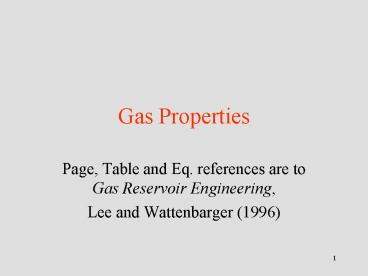Gas Properties
1 / 34
Title: Gas Properties
1
Gas Properties
- Page, Table and Eq. references are to Gas
Reservoir Engineering, - Lee and Wattenbarger (1996)
2
Objectives Gas Properties
- What properties are important for reservoir
engineering - Which methods are up-to-date and/or simple
- How to calculate important properties
- How to calculate properties in Excel
3
Standard Conditions(see p. 1)
- Tsc 60 oF
- psc 14.65 psia (Texas)
- 1 lb-mole 380.7 scf
4
Composition, Gas Gravity
- Composition
- Mole fraction of components, Table 1.2, p.4
- Table of component properties, Table 1.1, p.2
- M.W., p. 2, Eq. 1.10
- Gas gravity, ?g, p. 3, Eq. 1.12
5
Heating Value
- HV ? yi (HV)i
- Use Gross Heating Value, BTU/scf
- C1 (methane) 1010.0
- C2 (ethane) 1769.6
- C3 (propane) 2516.1
- i-C4, n-C4 (butanes) 3251.9, 3262.3
- i-C5,n-C5 (pentanes) 4000.0, 4008.9
- C6 (hexanes) 7755.9
6
Heating Value
- Use Gross Heating Value, BTU/scf
- CO2 0
- H2S 637.1
- N2 0
- He 0
- H2 324.2
7
z-Factor
- Real Gas, p. 2, Eq. 1.5
- pV z n R T
- Calculate pseudo critical properties, ppc and Tpc
- Kays rule (mole-wtd. averages), p. 3
- Suttons method, pp. 6, 7
- Piper, McCain and Corredor (see paper)
8
A simple chart to estimate pseudo critical
pressure, ppc and pseudo critical temperature,
Tpc from gas gravity
(limited to similar gases)
9
z-Factor
- Calculate pseudo reduced ppr and Tpr , p. 2
- Determine z as function of ppr and Tpr
- Figs. 1.7 and 1.8, pp. 14, 15
- Read z graphically, or
- Solve for z by iteration, p. 274
10
(No Transcript)
11
H2S, CO2 Corrections for ppc and Tpc
- Sutton, pp. 6,7
- Wichert and Aziz, pp. 7,8
- Piper, McCain, and Corredor, (see paper
Gasprop6.xls)
12
Density
Where,
R 10.73
M 29 ?g
Gravity gradient ? / 144 psi/ft
13
Formation volume factor
- Bg is either rcf/scf or RB/Mscf, p.16, 17
14
Compressibility
(see pp. 17, 18)
Ideal gas
Real gas
15
Gas Viscosity
- Almost never measured
- Lee, Gonzalez, Eakin method, p. 18
16
Real Gas Pseudopressure
- Reservoir flow potential
- Defined by Eq. 7.7, p. 169
17
Real Gas Pseudopressure
- Developed by Al-Hussainy, Ramey, and Crawford,
1966 - accounts for gas property variation
- p2 plots (Ideal Gas) can be used below 2,000 psia
because z? is almost constant, pp. 169, 170 - always used for pressure transient analysis
- should also be used for stabilized flow
18
Real Gas Pseudopressure
19
Real Gas Pseudopressure
20
Real Gas Pseudopressure
z µ almost constant below 2,000 psi , thus
21
Worksheet for Gas Properties
Gasprop6.xls
22
Separation of Wet Gas
qg1
qg2
qgST
Sep. 2
Sep. 1
S.T.
qo
Reservoir rich (wet) gas only
23
Raw (or wet) Gas Gravity
- When condensate (oil) production is condensed
from gas stream in wellbore/separator - Reconstruct gravity with oil molecules in the wet
gas, pp.11-15, Eqs. 1.37 and 1.38 - for overall separation, R is total GOR
- ?w (R ?g 4,602 ?o) / (R
133,316 ?o/Mo) - where R scf /S.T.Bbl ?o oil sp.
grav. 141.5 / (131.5 oAPI) - ?g oil sp. grav. bl Mo oil
M.W. 5,954/(API 8.811)
24
Raw (or wet) Gas Production
- Use Eq. 1.47, p. 13 to correct separator gas and
S. T. Oil production to Wet gas production from
the reservoir - Gp Gp,dry 133,316 Np ?o / Mo
- Gp scf ?o oil sp. grav.
- Np S.T.Bbl Mo oil M.W.
25
Water Vapor in Gas
- Not included in composition alalysis
- Bukaceks Correlation, p. 28,29, Eqs. 1.101-1.103
- lb/MMscf/(350 ? water S.G.) Bbl/MMscf
26
Worksheet for including water and
condensate vapor
WaterCondensate vapor.xls
27
Sampling a Gas Condensate Well
- Must be single phase in reservoir (above dew
point), Figs. 10.2, 10.3 - Downhole sample
- More difficult
- Only valid if single phase in wellbore
- Recombined sampling
- Requires accurate field GOR, lab matching
- Gas and liquid samples at primary separator
- Or, Total separator gas and stock tank oil
- (see SPE3, Table 4)
28
Lab Tests for Condensates
Constant Composition Expansion
(see SPE Test Case 3, SPE 12278)
Vapor
Liquid
p 3428 (D.P.)
3200
3000
2800 psia
29
Lab Tests for Condensates
Constant Composition Expansion
- Expansion at constant composition and reservoir
temperature - Quick and inexpensive
- Two phase volume measured
- Liquid volume sometimes measured
- not in Table 6, SPE3
30
Lab Tests for Condensates
Constant Volume Expansion, Depletion Study
(see SPE Test Case 3, SPE 12278)
produced gas ? Gp and yi
Vapor
Liquid
p 3428 (D.P.)
3000
3000
2400 psia
2400
31
Lab Tests for Condensates
Constant Volume Expansion, Depletion Study
- Carried out in steps (pressure decrements)
- Emulates production from constant pore volume
reservoir (depletion) - liquid does not flow to well, Table 7, SPE3
- Produced gas can be analyzed, Table 8, SPE3
- Separator ratios or plant products can be
calculated, Table 9, SPE3
32
Lab Tests for Condensates
Solubility and Swelling Test
- Designed to approximate effect of injected gas on
phase behavior and dew point - Performed in increments of gas injection.
- Add injection gas
- Measure new dew point with CCE
- Measure swollen volume at new dew point
- (See SPE3, Tables 10-15)
33
Hydrates
- When water hydrates are in gas
- Slushy ice plugs lines, valves, etc.
- when below freezing point, pp.29-31
- when pressure drop is too great, pp. 29-31
- Solutions
- dry gas with ethylene glycol
- avoid large pressure drops
- heat gas stream
- add methanol to lower freezing point
34
Objectives Gas Properties
- Which methods are up-to-date and/or simple
- What properties are important for reservoir
engineering - How to calculate important properties
- How to calculate properties in Excel































